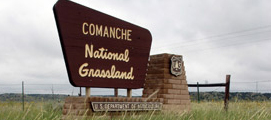THE ANCIENT ONES
For many thousands of years the area that would become the Comanche National Grassland was home to prehistoric peoples. The earliest evidence found in the grasslands suggests that early paleo-hunters entered the region after the last ice some 12,000 years ago. Surface finds of these early big game hunters have been found.
As the climate warmed and the larger mammals (prehistoric bison, mammoth, and sloth) became extinct these early hunters relied more and more on the smaller game that was to be found in the region into historic times. There also seems to be more emphasis on the processing of plant foods. These big game hunters evolved into true hunters and gatherers with a more complex social structure as evidenced by more varied stone tools, both for hunting and plant processing. It was during this period about 8,000 years ago that rock art began to appear on the canyon walls. Around 1,800 years ago there was another cultural shift when pottery and the bow-and-arrow were developed. Though these ancient people were still hunters and gathers, more permanent structures, reminiscent of the early Anasazi pit houses, began to appear. Agriculture began on a rudimentary level. This Ceramic Period, as it is called in southeast Colorado, lasted into the historic times when, in the early 1600s, these peoples were displaced by the Apache peoples, who in turn were replaced by the Comanche in the 1700s.
RIVER OF LOST SOULS
The Purgatory River is a haunted river. For thousands of years it has witnessed the comings and goings of many peoples; many cultures have played out their human drama here before disappearing into eternity. The Native Americans knew the river as the Spirit River – maybe that is what originally inspired the name of the Purgatory River, or perhaps, if legend is correct, this is really the river of lost souls.
It is said that once long ago, in the earliest days of Spanish exploration in the southwest, a Spanish military expedition set out from the Spanish colony of New Mexico to find an overland route to their colony in Florida. The military expedition left Santa Fe, loaded down with gold to pay off the soldiers upon their arrival, and were never seen or heard from again. Later, an account by an Indian native circulated that the expedition was wiped out by Indians. Many Spanish felt, that if this was true, the men died without the benefit of clergy and their souls were trapped in Purgatory. The Spanish began calling the river El Rio de las Animas Perdidas en Puratorio or The River of Lost Souls in Purgatory.
Tarantula Migration
Later French trappers referred to the river as the Purgatoire (pronounced Pur-ga-twa) and American explorers and settlers corrupted the pronunciation to become Picketwire. Anyhow, that’s the legend and today we call this the Purgatory River. Anyone who has spent time down in the canyons can feel a sense of history all around them and maybe something else – a certain spirit about the place – could this be the faint echoes of the lost souls doomed to wander her banks forever?
VOGEL CANYON
Just a short drive from La Junta, beautiful Vogel Canyon is always a popular destination because it has something for everybody - from a short hike to a quiet picnic. The park provides picnic grounds and hiking trails with a variety of difficulty and length. Four hiking trails take you to the canyon bottom and mesa top. You can drive your vehicle right up to the picnic area and the short Canyon Overlook Trail is Wheel chair accessible. Hikers must beware of rattlesnakes and scorpions, as well as pack appropriate dress for late afternoon showers, and bring plenty of water.
Vogel canyon is a tributary of the Purgatory River and offers a varied habit from short grass prairies to the pinion-juniper ecosystem. Two permanent springs located at the bottom of the canyon support a variety of wildlife. Native Americans lived in the canyon for thousands of years and left rock art visible on the canyon walls. The canyon was on the route of the Barlow and Sanderson Stage line in the 1870s. You can still see the ruins of one of their stage stations down in the canyon (photo above right). As you hike the trails in Vogel Canyon you will see many stone ruins of homesteads and corrals with walls constructed of native stone - reminders of the heavy 19th century sheep and cattle ranching days in the area.
PICKETWIRE CANYON
Located just 30 miles south of La Junta, Picketwire Canyon is great for a more strenuous adventure. No motorized vehicles are allowed in the canyon except for guided tours led by Comanche National Grassland rangers. The canyon is open to the public though, the Withers Canyon Trailhead on the mesa above the canyon offers access to Picketwire Canyon for hiking, horseback riding and mountain biking. Picketwire Canyon contains one of the largest dinosaur track beds in the world, ruins of an old Mexican mission and settlement, Native American rock art, and an early 19th century ranch, now preserved by the Comanche National Grassland. Plan carefully if you plan to visit the canyon as your hike can be anywhere from 2 miles to 17 miles round trip depending on where you go. For example it is over 10 miles round trip to the dinosaur track site – the most popular destination in the canyon.

